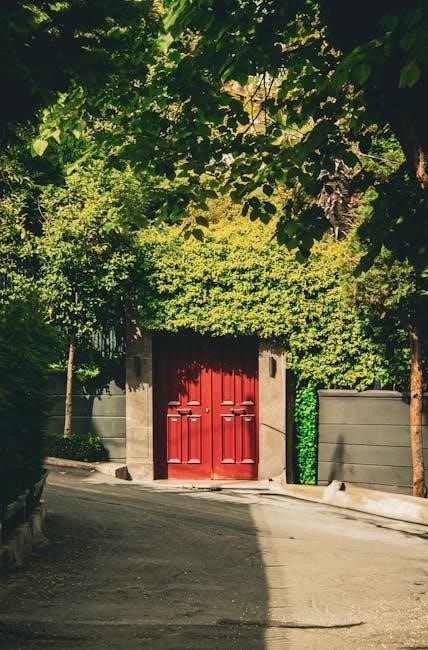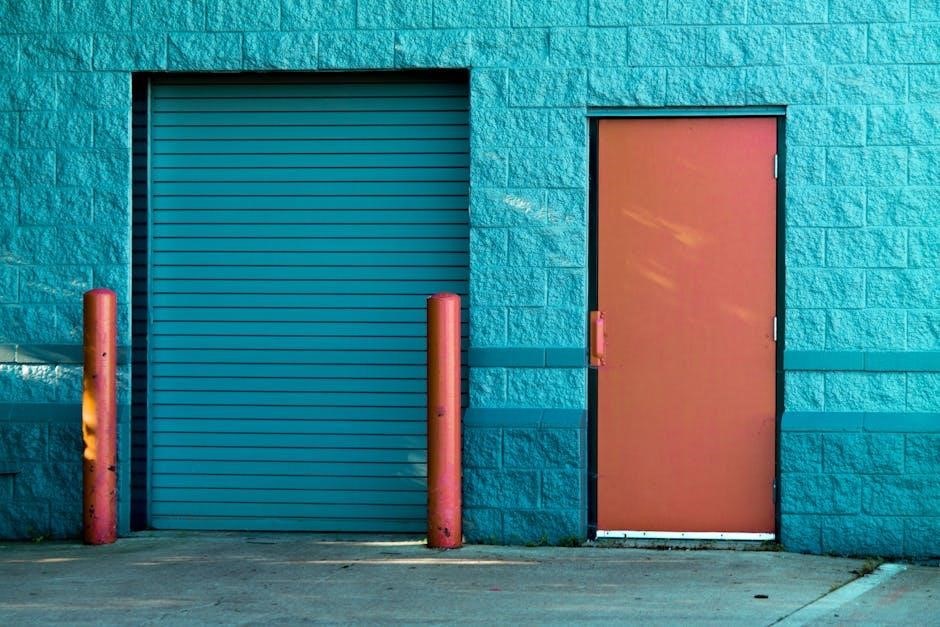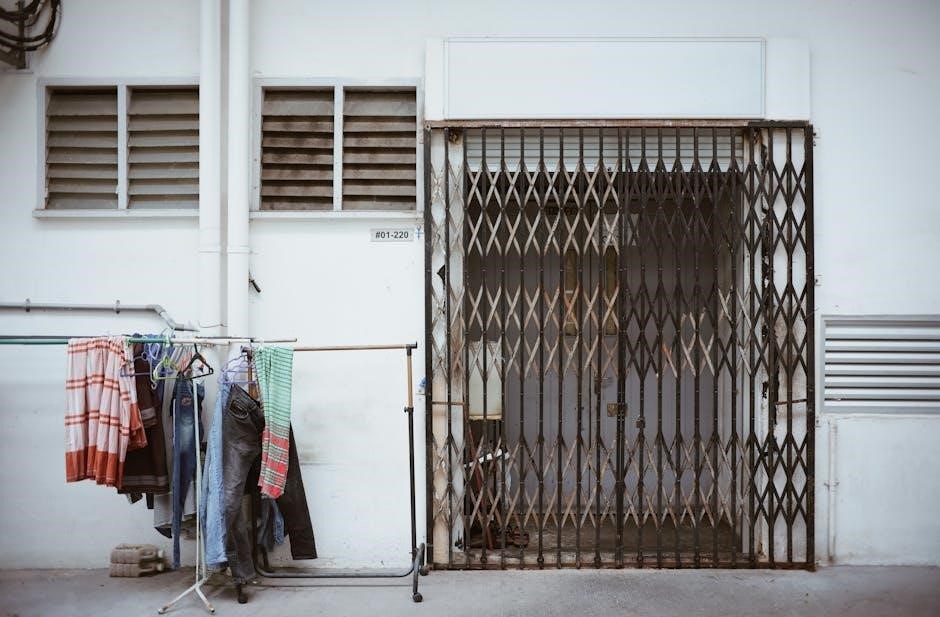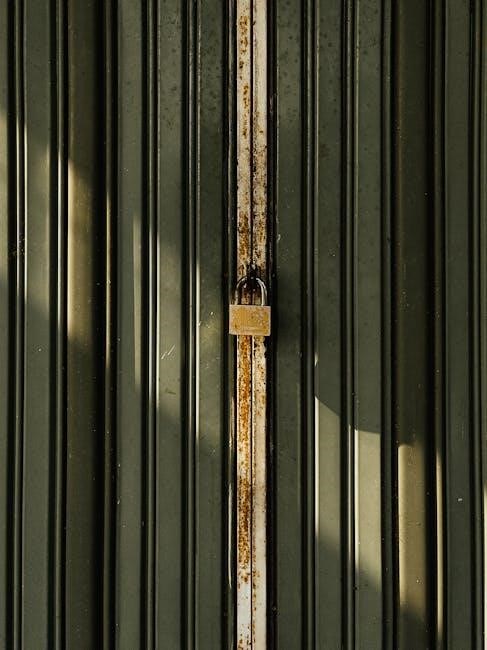Sliding gates offer a practical and stylish solution for securing properties, blending functionality with modern design to enhance security, space efficiency, and aesthetic appeal for various settings.
What Are Sliding Gates?
Sliding gates are gates that move horizontally along a wall or fence, typically using rollers or wheels mounted on the gate and a track system. They are commonly used for entrances and exits, offering a space-saving solution compared to traditional swing gates. Made from materials like metal, wood, or vinyl, sliding gates can be manual or automated, providing functionality and security for residential, commercial, or industrial properties.
Why Choose Sliding Gates?
Sliding gates are a popular choice due to their space-saving design, ease of operation, and versatility. They offer enhanced security, are ideal for tight spaces, and can be automated for convenience. With minimal maintenance and a wide range of design options, sliding gates cater to both modern and traditional aesthetics, making them a practical and stylish solution for homes, businesses, and large properties alike.
Popular Applications of Sliding Gates
Sliding gates are widely used in residential, commercial, and industrial settings due to their space-saving design. They are ideal for driveways, parking lots, and entrances where swing gates are impractical. Additionally, they are commonly installed in schools, hospitals, and apartment complexes for secure access control. Their versatility makes them suitable for both modern and traditional properties, offering a practical solution for enhancing security and managing traffic flow efficiently in various environments.
Types of Sliding Gates
Sliding gates come in various styles, including single panel, double panel, telescoping, and cantilever designs, each offering unique benefits for different spaces and functional requirements.
Single Panel Sliding Gates
Single panel sliding gates are a popular choice for their simplicity and space efficiency. They consist of one large panel that slides horizontally on a track, making them ideal for wide entrances. These gates are versatile, suitable for both residential and commercial use, and can be made from various materials like wood, metal, or vinyl. They offer a sleek, modern appearance and can be easily automated for convenience. Their compact design saves space compared to traditional swing gates.
Double Panel Sliding Gates
Double panel sliding gates are ideal for wider entrances, offering enhanced durability and stability. Comprising two panels that slide together, they provide a secure and space-efficient solution. Often used in commercial or residential settings with larger driveways, these gates can be customized to suit various designs and materials. Their robust construction makes them suitable for heavy-duty use, while their sleek appearance enhances property aesthetics, making them a practical choice for modern homeowners and businesses alike.
Telescoping Sliding Gates

Telescoping sliding gates are a space-saving solution, ideal for wide openings. They consist of multiple panels that slide into each other, compactly storing when open. This design is perfect for larger properties or areas with limited side space. Durable and versatile, telescoping gates can be customized with various materials and designs, offering both security and aesthetic appeal for residential or commercial use.
Cantilever Sliding Gates
Cantilever sliding gates operate without ground tracks, making them ideal for uneven or sloped surfaces. They use a counterbalance system to glide smoothly along overhead tracks, providing excellent space-saving and low-maintenance solutions. These gates are perfect for large openings and offer enhanced security. Their sleek design and versatility make them suitable for both residential and commercial properties, ensuring durability and aesthetic appeal while requiring minimal upkeep compared to traditional gate systems.

Materials and Designs
Sliding gates are crafted from durable materials like steel, aluminum, and wood, offering modern and traditional designs with finishes and accessories to suit various architectural styles.
Materials Used for Sliding Gates
Sliding gates are crafted from durable materials like steel, aluminum, wood, and vinyl, each offering unique benefits. Steel gates provide maximum security and strength, while aluminum is lightweight and corrosion-resistant. Wooden gates add a traditional aesthetic, and vinyl options are low-maintenance and weather-resistant. These materials ensure longevity, versatility, and aesthetic appeal, catering to various architectural styles and security needs. Proper material selection enhances both functionality and visual appeal.
Modern vs. Traditional Designs
Modern sliding gates emphasize sleek lines, minimalist aesthetics, and innovative materials like steel or aluminum, often featuring automation. They cater to contemporary homes and urban spaces, offering space efficiency and low maintenance. Traditional designs, however, showcase ornate details, classic patterns, and timeless materials like wood or wrought iron, appealing to those seeking a vintage or rustic charm. Both styles enhance security and functionality while reflecting personal taste and property architecture.
Custom Sliding Gate Designs
Custom sliding gate designs allow homeowners and businesses to create unique, tailored solutions that match their specific needs and preferences. From modern minimalist styles to intricate decorative patterns, these gates can be crafted using a variety of materials and finishes. Advanced features like automation integration and security enhancements can also be incorporated. Custom designs ensure functionality while adding a personal touch, making them a popular choice for those seeking both practicality and aesthetic appeal.

Installation Process
Installing sliding gates requires precise steps, proper tools, and site preparation to ensure smooth operation, security, and durability, following manufacturer guidelines for optimal results.
Steps to Install a Sliding Gate
Start by preparing the site, ensuring the ground is level and clear. Mark the area for the gate’s track and posts. Dig holes for the posts, pour concrete footings, and set the posts securely. Attach the sliding gate track to the posts and install rollers on the gate. Mount the gate panels, ensuring proper alignment. Install the gate opener and safety features like sensors. Test the gate’s smooth operation and make adjustments as needed. Consult professionals for complex setups.
Tools and Equipment Required
Installing a sliding gate requires specific tools and equipment to ensure proper setup and functionality. Essential items include a power drill, wrenches, measuring tape, level, concrete mixer, post-hole digger, and safety gear like gloves. Additional tools such as a laser level, impact driver, and saw may be needed for precise adjustments and custom fits. Having the right equipment ensures a smooth and efficient installation process, minimizing potential errors and safety risks.
Preparation and Site Readiness
Before installing a sliding gate, ensure the site is prepared. Clear the area of debris, vegetation, and obstructions. Mark the intended path for the gate’s track and ensure the ground is level. Check for underground utilities to avoid damage. Measure the space accurately to fit the gate and track system. Prepare the foundation for posts and ensure all materials are within reach. Proper site readiness ensures a smooth and efficient installation process.

Maintenance and Upkeep
Regular lubrication of rollers and hinges, along with cleaning debris from tracks, ensures smooth operation. Inspect for rust or wear and address issues promptly to prevent damage.
Regular Maintenance Tips
Regular lubrication of hinges and rollers ensures smooth operation. Clean the track periodically to remove debris. Inspect the gate for wear and tear, replacing worn parts promptly. Check the alignment and tighten bolts as needed. Apply rust-inhibiting coatings to metal components. Trim nearby vegetation to prevent obstruction. For automated gates, test the opener’s safety features monthly. Schedule professional inspections annually to maintain optimal functionality and safety.
Common Issues and Solutions
Sliding gates may face issues like obstructions, roller damage, or track misalignment, causing malfunctions. Regular maintenance, such as cleaning the track and lubricating moving parts, can prevent these problems. If rollers are damaged, replacing them promptly ensures smooth operation. Misaligned tracks should be adjusted by professionals to avoid further damage. Addressing these issues early helps maintain the gate’s efficiency and longevity, ensuring reliable performance over time.

When to Call a Professional
If your sliding gate experiences complex issues like motor failure, track misalignment, or severe damage, it’s best to call a professional. They can diagnose problems accurately and provide specialized solutions. Professionals are also essential for custom designs, large-scale installations, or when safety concerns arise. Don’t hesitate to seek expert help to ensure proper functionality, security, and longevity of your sliding gate system. Regular maintenance can also benefit from professional oversight.

Automation and Accessories
Automation and accessories enhance sliding gate functionality, offering convenience, security, and durability through advanced openers, sensors, and complementary features tailored to modern property needs.
Types of Sliding Gate Openers
Sliding gate openers come in various types, including hydraulic, electric, and solar-powered options. Hydraulic openers are durable and suitable for heavy gates, while electric models are cost-effective and easy to install. Solar-powered openers are eco-friendly and ideal for remote locations. Each type offers unique benefits, catering to different needs and preferences, ensuring smooth and efficient gate operation.
Advantages of Automated Gates
Automated sliding gates enhance convenience, offering remote or sensor-activated operation, perfect for modern lifestyles. They improve security by reducing unauthorized access and providing real-time monitoring. With automation, maintenance needs decrease as manual handling is minimized. Additionally, automated gates integrate seamlessly with smart home systems, adding value and appeal to properties. Their smooth operation and energy efficiency make them a practical choice for homeowners seeking both functionality and style.
Additional Accessories for Sliding Gates
Additional accessories for sliding gates can enhance functionality and security. These include:
• Gate openers for smooth automation,
• Safety sensors to prevent accidents,
• Security alarms for added protection,
• Lighting kits for visibility,
• Protective coatings for durability,
• Control systems like remotes or keypads.

Cost Considerations
Sliding gates’ costs vary based on materials, size, automation, and design complexity, requiring careful budgeting to balance quality, functionality, and aesthetic preferences effectively.
Factors Affecting the Cost
The cost of sliding gates varies based on materials, size, automation features, and design complexity. High-quality materials like steel or wrought iron increase expenses, while vinyl or aluminum may be more affordable. Larger gates require more material and labor, raising prices. Automated systems, including motors and sensors, add significant costs. Custom designs, installation location, and local labor rates also influence the final price, making budgeting essential for tailored solutions.
Budgeting for a Sliding Gate
Budgeting for a sliding gate involves considering materials, size, automation, and installation costs. Set a realistic budget based on your property’s needs and gate usage. Compare quotes from suppliers to find the best value. Consider long-term maintenance and energy efficiency. Optional features like automation and advanced security systems may increase initial costs but offer convenience. Plan for potential future upgrades to ensure your gate remains functional and secure over time.
Long-Term Cost Efficiency
Sliding gates offer long-term cost efficiency due to their durability and low maintenance requirements. Durable materials like steel or aluminum reduce the need for frequent repairs, while automated systems minimize wear and tear. Proper installation and regular upkeep further extend their lifespan. Energy-efficient automation and reduced insurance costs also contribute to long-term savings, making sliding gates a cost-effective solution for property security and access control over time.

Safety and Security
Sliding gates enhance property safety and security with features like motion sensors, automatic locks, and robust materials, ensuring reliable protection and peace of mind for residents and assets.
Safety Features to Consider
When installing sliding gates, prioritize safety features like obstacle detection sensors, emergency stop mechanisms, and secure locking systems. Regular maintenance ensures smooth operation and prevents accidents. Additionally, consider protective barriers and child safety locks to enhance security. These features not only protect users but also comply with safety regulations, ensuring a reliable and secure gating system for any property.
Security Benefits of Sliding Gates
Sliding gates provide robust security features, deterring unauthorized access and protecting properties effectively. Their sturdy construction and ability to be automated enhance control over entry points. Customizable with spikes, locks, and anti-climb systems, they offer heightened protection. Integration with CCTV, alarms, and sensors further strengthens security. Their visibility and solid barrier capabilities ensure a safer environment, making them a reliable choice for residential and commercial settings.
Potential Hazards and Solutions
Potential hazards with sliding gates include mechanical failures, obstruction risks, and automation malfunctions. Regular maintenance can prevent these issues. Install safety sensors to detect obstacles and ensure smooth operation. Address wear and tear promptly to avoid accidents. Automated gates should have emergency stop features. Proper installation and professional inspections can mitigate risks, ensuring reliable and safe functionality over time.

Troubleshooting Common Issues
Identify common sliding gate issues promptly to prevent further damage. Inspect tracks, clean debris, and lubricate rollers. Adjust misaligned panels and check for worn-out parts regularly for smooth operation.
Gate Not Opening or Closing Properly
If your sliding gate isn’t functioning correctly, it could be due to track misalignment, obstruction, or motor issues. Check for debris on the track and ensure proper lubrication. Misaligned rollers or worn-out parts may also cause malfunction. If manual operation is difficult, the gate may be off balance. Regular maintenance, such as cleaning and lubricating moving parts, can prevent such issues. If problems persist, professional assistance may be required to realign or repair components.
Noise and Vibration Problems
Noise and vibration issues in sliding gates often arise from worn rollers, lack of lubrication, or misaligned tracks. Regular lubrication of hinges and rollers can significantly reduce operational noise. Ensuring the gate is properly aligned and tightened can minimize vibrations. Replacing worn parts and using noise-dampening materials, such as rubber pads, can also help mitigate these problems, ensuring smoother and quieter operation over time.
Wear and Tear Solutions
To address wear and tear on sliding gates, regular lubrication of hinges and rollers is essential. Inspect and tighten loose screws periodically. Replace damaged panels or wheels promptly to prevent further deterioration. Use weather-resistant materials to withstand harsh conditions. Ensure proper alignment of tracks and rollers for smooth operation. Schedule professional inspections to identify and resolve issues early, maintaining longevity and functionality.
- Lubricate moving parts regularly.
- Replace worn-out components promptly.
- Ensure proper alignment of tracks.
Sliding gates are a versatile, secure, and space-efficient solution, offering both functionality and aesthetic appeal for homes and commercial properties, with options to suit every need.
Final Thoughts on Sliding Gates
Sliding gates are a practical and versatile solution for property security, offering durability, space efficiency, and aesthetic appeal. They cater to diverse needs, from residential to commercial settings, ensuring safety and convenience; With proper installation and maintenance, sliding gates provide long-term reliability and enhance property value.
Whether automated or manual, these gates adapt to modern lifestyles, blending functionality with design. Consider consulting professionals for tailored solutions that meet your specific requirements and ensure optimal performance over time.
Next Steps for Installation or Upgrade
After deciding to install or upgrade your sliding gate, start by evaluating your property’s specific needs and measuring the area accurately. Consult with professionals to choose the right design and material that suits your budget and preferences. Purchase high-quality components, including tracks, rollers, and automation systems if desired. Schedule a professional installation to ensure proper alignment and smooth operation. Finally, test the gate thoroughly and consider routine maintenance to maximize its longevity and efficiency.
